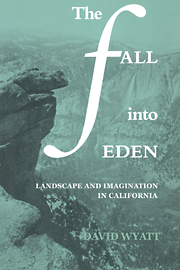Book contents
- Frontmatter
- Contents
- List of illustrations
- Acknowledgments
- Prologue: The mythology of the region
- 1 Spectatorship and abandonment: Dana, Leonard, and Frémont
- 2 Muir and the possession of landscape
- 3 King and catastrophe
- 4 Mary Austin: nature and nurturance
- 5 Norris and the vertical
- 6 Steinbeck's lost gardens
- 7 Chandler, marriage, and “the Great Wrong Place”
- 8 Jeffers, Snyder, and the ended world
- Epilogue: Fictions of space
- Notes
- Bibliography
- Index
Epilogue: Fictions of space
Published online by Cambridge University Press: 18 December 2009
- Frontmatter
- Contents
- List of illustrations
- Acknowledgments
- Prologue: The mythology of the region
- 1 Spectatorship and abandonment: Dana, Leonard, and Frémont
- 2 Muir and the possession of landscape
- 3 King and catastrophe
- 4 Mary Austin: nature and nurturance
- 5 Norris and the vertical
- 6 Steinbeck's lost gardens
- 7 Chandler, marriage, and “the Great Wrong Place”
- 8 Jeffers, Snyder, and the ended world
- Epilogue: Fictions of space
- Notes
- Bibliography
- Index
Summary
Innocent of history and unsure of its culture, America turned to its landscapes as a unique possession to which its response could give meaning and value. For Milton, nature had been a book written by someone else (God), and the “sensuous poverty” of his Edenic landscapes expressed his conviction that any natural prospect serves ordained purposes in a stable spiritual allegory. The proper response to landscape was awe, and worship. For Emerson, nature has become a text, and the proper response to landscape is curiosity, and interpretation. Emerson founds his declaration of independence on the indeterminacy of the natural world: Nature declares that meaning has passed over to the discretion of the eye. To this day strong imaginations in America have remained geographers, engaged, in Carl Sauer's phrase, in “a reading the face of the earth.”
Through their encounters with natural space, writers on the continent developed new ways of knowing. Unsponsored imaginations found in unfallen landscape a stage on which to reenact Milton's story: We have heard enough about American Eves and Adams. For those who eschewed archetypes, landscape could solicit the self into unexplored dimensions of autobiographical expression. In its responsiveness to projection, landscape evolved into a palimpsest on which Americans could revise Old-World ideas about friendship and marriage, work and play, sanity and the sublime. And in agreeing to read the face of the continent as a measure of its destiny, the young country proposed to the world that the images of a nation could be grounded in natural as well as in political, cultural, and military history.
- Type
- Chapter
- Information
- The Fall into EdenLandscape and Imagination in California, pp. 206 - 210Publisher: Cambridge University PressPrint publication year: 1986

